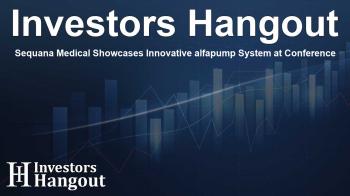Sequana Medical Showcases Innovative alfapump System at Conference

Sequana Medical Highlights alfapump System at Major Conference
Recently, Sequana Medical NV, an innovative company focused on transforming the treatment landscape for drug-resistant fluid overload, particularly in patients with liver disease and heart failure, made headlines. Their groundbreaking alfapump system was prominently featured at a key medical conference focused on interventional radiology. This event, the Society of Interventional Radiology's SIR EDGE 2025, served as a platform for discussing the latest advancements in medical technology.
Clinical Advantages of the alfapump System
The presentation, intriguingly titled “Not the Alpha Male, the Alfapump!”, elucidated the significant clinical impacts and revolutionary nature of the alfapump technology. Leading the discussion was Dr. Ziv Haskal, a Professor of Radiology and Interventional Radiology at the University of Virginia. He emphasized that the alfapump signifies a major shift in managing refractory ascites, specifically for patients who are not suitable candidates for traditional procedures like TIPS (Transjugular Intrahepatic Portosystemic Shunt). The device provides a continuous, automated solution for removing excess ascitic fluid, freeing patients from the repeated discomfort of paracentesis—a procedure that involves draining fluid from the abdomen.
Insights from Sequana Medical Officials
Dr. Gijs Klarenbeek, the Chief Medical Officer at Sequana Medical, expressed enthusiasm regarding the presentation at SIR EDGE, highlighting the positive reception the alfapump technology received. He noted that the device represents a much-needed modernization in the treatment approach for patients who have struggled with long-standing and often ineffective care. As Sequana Medical prepares for its U.S. commercialization, the team is focused on educating interventional radiologists about how the alfapump can significantly benefit patients.
Regulatory Recognition and Future Plans
Obtaining U.S. FDA Premarket Approval in December 2024 marked a critical milestone for the alfapump system, enabling it to treat recurrent or refractory ascites caused by liver cirrhosis. This distinction makes it the first active implantable medical device of its kind approved in the U.S., capable of automatically and continuously alleviating ascites. In addition, as of October 1, 2025, the alfapump system was granted a New Technology Add-on Payment by CMS for procedures conducted in hospital inpatient settings. With commercial implants expected to roll out in the upcoming months, Sequana Medical is poised to significantly improve patient care in the U.S.
Important Safety Information for alfapump
The alfapump system is designed exclusively for single-patient use among adults afflicted with refractory or recurrent ascites due to liver cirrhosis. Its innovative design allows for efficient removal of excess peritoneal fluid into the bladder, which is subsequently eliminated through normal urination. However, certain contraindications do exist; for instance, it is essential to note that the alfapump is not MRI-safe. This restriction is crucial for patients to understand, as undergoing an MRI could result in significant complications. Moreover, implantation of the alfapump may carry risks such as infection, complications related to the surgical procedure, and adverse effects related to pump functionality.
The Future of Sequana Medical
As a pioneer in addressing severe fluid overload, Sequana Medical continues to focus on enhancing treatment options for patients facing chronic conditions such as liver disease and heart failure. Their proprietary alfapump technology, among others under development, aims to not only reduce the burden of treatment but also to improve quality of life for patients. Currently listed on Euronext Brussels, Sequana Medical is committed to innovating further in this critical field, striving to provide cutting-edge solutions for a patient population that often lacks effective treatment options.
Frequently Asked Questions
What is the alfapump system?
The alfapump system is an active implantable medical device that automatically removes ascitic fluid from the abdomen into the bladder, intended for patients with liver cirrhosis.
How does the alfapump benefit patients?
This device alleviates the need for repetitive paracentesis procedures, enhancing comfort and improving the overall quality of life for patients with refractory ascites.
Who presented at the SIR EDGE 2025 conference?
Dr. Ziv Haskal, a Professor of Radiology, discussed the clinical impacts and innovative solutions offered by the alfapump system during the conference.
What regulatory approval has the alfapump received?
The alfapump system received U.S. FDA Premarket Approval in December 2024, allowing it to be used for treating recurrent or refractory ascites due to liver cirrhosis.
Is the alfapump system available in Canada?
No, the alfapump system is currently not approved for use in Canada.
About The Author
Contact Riley Hayes privately here. Or send an email with ATTN: Riley Hayes as the subject to contact@investorshangout.com.
About Investors Hangout
Investors Hangout is a leading online stock forum for financial discussion and learning, offering a wide range of free tools and resources. It draws in traders of all levels, who exchange market knowledge, investigate trading tactics, and keep an eye on industry developments in real time. Featuring financial articles, stock message boards, quotes, charts, company profiles, and live news updates. Through cooperative learning and a wealth of informational resources, it helps users from novices creating their first portfolios to experts honing their techniques. Join Investors Hangout today: https://investorshangout.com/
The content of this article is based on factual, publicly available information and does not represent legal, financial, or investment advice. Investors Hangout does not offer financial advice, and the author is not a licensed financial advisor. Consult a qualified advisor before making any financial or investment decisions based on this article. This article should not be considered advice to purchase, sell, or hold any securities or other investments. If any of the material provided here is inaccurate, please contact us for corrections.

